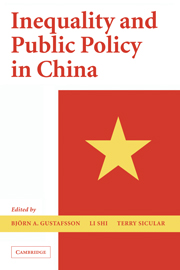Book contents
- Frontmatter
- Contents
- List of Tables and Figures
- Contributors
- Acknowledgments
- 1 Inequality and Public Policy in China: Issues and Trends
- 2 Income Inequality and Spatial Differences in China, 1988, 1995, and 2002
- 3 Growth and Distribution of Household Income in China between 1995 and 2002
- 4 Explaining Incomes and Inequality in China
- 5 The Distribution of Wealth in China
- 6 Growth, Inequality, and Poverty: A Comparative Study of China's Experience in the Periods before and after the Asian Crisis
- 7 What Has Economic Transition Meant for the Well-Being of the Elderly in China?
- 8 Inequity in Financing China's Health Care
- 9 China's Emerging Urban Wage Structure, 1995–2002
- 10 Unemployment, Earlier Retirement, and Changes in the Gender Income Gap in Urban China, 1995–2002
- 11 What Determines Living Arrangements of the Elderly in Urban China?
- 12 The Impact of Village-Specific Factors on Household Income in Rural China
- 13 The Redistributive Impact of Taxation in Rural China, 1995–2002: An Evaluation of Rural Taxation Reform at the Turn of the Century
- Appendix: The 1995 and 2002 Household Surveys: Sampling Methods and Data Description
- Index
- References
10 - Unemployment, Earlier Retirement, and Changes in the Gender Income Gap in Urban China, 1995–2002
Published online by Cambridge University Press: 25 July 2009
- Frontmatter
- Contents
- List of Tables and Figures
- Contributors
- Acknowledgments
- 1 Inequality and Public Policy in China: Issues and Trends
- 2 Income Inequality and Spatial Differences in China, 1988, 1995, and 2002
- 3 Growth and Distribution of Household Income in China between 1995 and 2002
- 4 Explaining Incomes and Inequality in China
- 5 The Distribution of Wealth in China
- 6 Growth, Inequality, and Poverty: A Comparative Study of China's Experience in the Periods before and after the Asian Crisis
- 7 What Has Economic Transition Meant for the Well-Being of the Elderly in China?
- 8 Inequity in Financing China's Health Care
- 9 China's Emerging Urban Wage Structure, 1995–2002
- 10 Unemployment, Earlier Retirement, and Changes in the Gender Income Gap in Urban China, 1995–2002
- 11 What Determines Living Arrangements of the Elderly in Urban China?
- 12 The Impact of Village-Specific Factors on Household Income in Rural China
- 13 The Redistributive Impact of Taxation in Rural China, 1995–2002: An Evaluation of Rural Taxation Reform at the Turn of the Century
- Appendix: The 1995 and 2002 Household Surveys: Sampling Methods and Data Description
- Index
- References
Summary
Introduction
Urban China was an egalitarian society in the 1980s and even the early 1990s. Income inequality among urban residents was extremely low compared to other developing countries (Adelman and Sunding 1987; Khan et al. 1992; Gustafsson and Li 1998). Wage inequality among urban workers was also very low (Knight and Song 1993). In explaining total inequality of earnings in urban China the gender gap in earnings between urban male and female workers was observed as relatively unimportant compared to other explanatory variables such as ownership structure, economic sector, and location (Knight and Song 1993; Gustafsson and Li 2000). The narrow gender gap was related partly to the implementation of a full employment policy, which was firmly considered as an advantage of the socialist system, and partly to a political ideology that emphasized equalizing earnings between male and female workers.
Since the mid-1990s urban reforms have speeded up in terms of reconstructing urban industries and enterprises, changing the employment system and retirement arrangements, and remodeling social security. As a result of implementation of the xiagang (layoff) policy, large numbers of urban workers have been laid off and have become unemployed or xiagang workers. At the same time, some early retirement programs were introduced to reduce redundant workers in enterprises. Several studies examine the number of unemployed and xiagang workers and the adverse consequences they have encountered after being laid off, such as difficulties becoming reemployed and their reduced wages upon being reemployed (for examples, see Appleton et al. 2002; Knight and Li 2002).
- Type
- Chapter
- Information
- Inequality and Public Policy in China , pp. 243 - 266Publisher: Cambridge University PressPrint publication year: 2008
References
- 5
- Cited by



